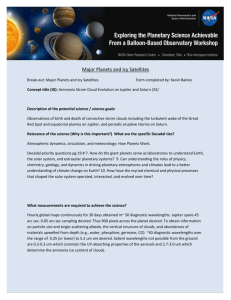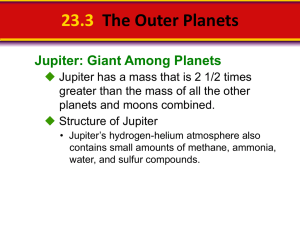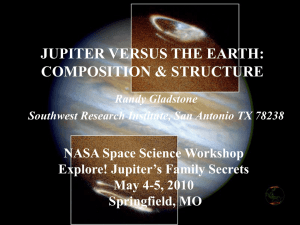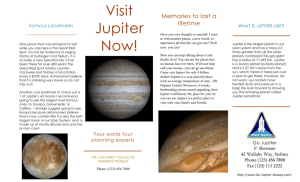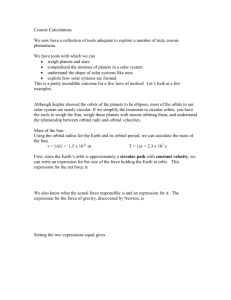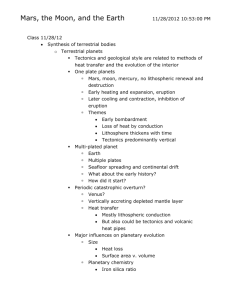Sample Final - Lawrence University
advertisement
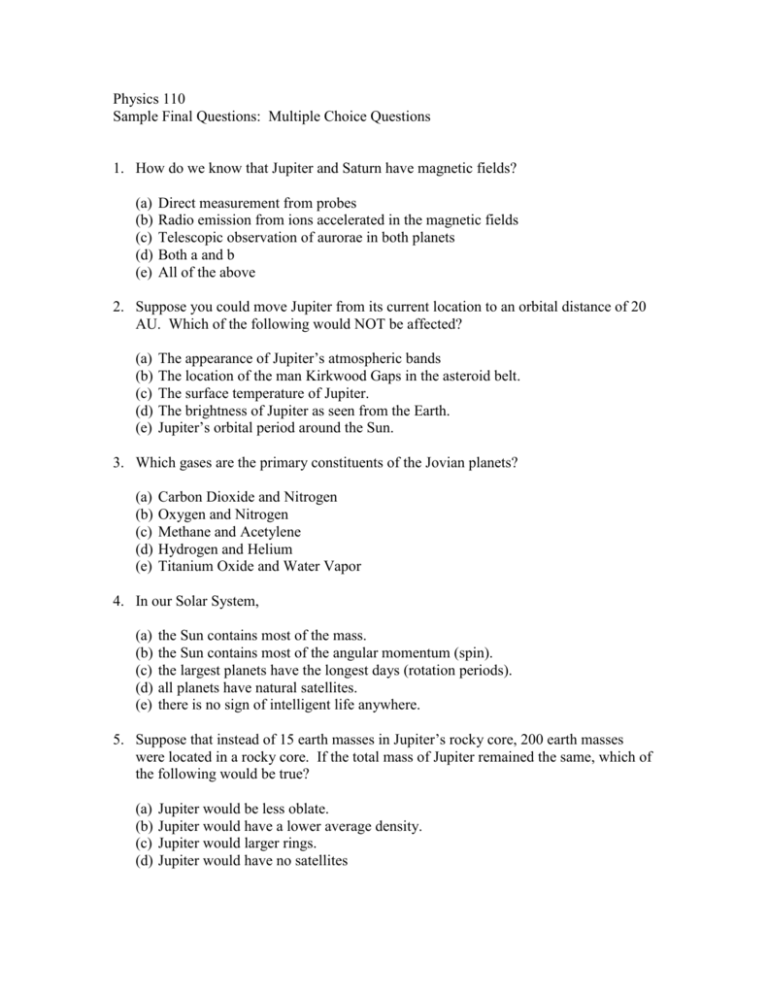
Physics 110 Sample Final Questions: Multiple Choice Questions 1. How do we know that Jupiter and Saturn have magnetic fields? (a) (b) (c) (d) (e) Direct measurement from probes Radio emission from ions accelerated in the magnetic fields Telescopic observation of aurorae in both planets Both a and b All of the above 2. Suppose you could move Jupiter from its current location to an orbital distance of 20 AU. Which of the following would NOT be affected? (a) (b) (c) (d) (e) The appearance of Jupiter’s atmospheric bands The location of the man Kirkwood Gaps in the asteroid belt. The surface temperature of Jupiter. The brightness of Jupiter as seen from the Earth. Jupiter’s orbital period around the Sun. 3. Which gases are the primary constituents of the Jovian planets? (a) (b) (c) (d) (e) Carbon Dioxide and Nitrogen Oxygen and Nitrogen Methane and Acetylene Hydrogen and Helium Titanium Oxide and Water Vapor 4. In our Solar System, (a) (b) (c) (d) (e) the Sun contains most of the mass. the Sun contains most of the angular momentum (spin). the largest planets have the longest days (rotation periods). all planets have natural satellites. there is no sign of intelligent life anywhere. 5. Suppose that instead of 15 earth masses in Jupiter’s rocky core, 200 earth masses were located in a rocky core. If the total mass of Jupiter remained the same, which of the following would be true? (a) (b) (c) (d) Jupiter would be less oblate. Jupiter would have a lower average density. Jupiter would larger rings. Jupiter would have no satellites 6. Which gas is present, in varying amounts, in the atmospheres of the three largest terrestrial planets? (a) Hydrogen (b) Carbon Dioxide (c) Helium (d) Oxygen (e) Hydrosulfuric Acid 7. Why are mountains and volcanoes on Mars so much taller on Mars than on the Earth? (a) Mars lacks plate tectonics and has a lower surface gravity than the Earth. (b) The atmospheric pressure on Mars is much lower than on the Earth. (c) The surface of mars is composed of low-density ices. (d) Gigantic asteroid impacts actually created all of the Martian “volcanoes”. (d) No natural structure on Mars is taller than the tallest structures on the Earth. 8. The cloud decks of Uranus and Neptune occur at the same altitude and are spread over the same vertical distance. This is due to similarities in (a) (b) (c) (d) (e) axial tilt and orbital inclination. surface gravity and temperature. mass and rotation rate. density and rotation rate. temperature and orbital eccentricity. 9. One of the effects of the Moon on the Earth is a slowing of the Earth’s rotation period; billions of years from now, the ‘day” will be longer than 50 hours. Which of the following would result from this deceleration? (a) (b) (c) (d) (e) The Earth’s orbital period will increase as well. The Earth’s magnetic field will decrease in strength. The Earth’s ozone layer will disappear completely. The Earth’s density will increase. The Earth’s mass will decrease. 10. Which major satellite has a nitrogen atmosphere thicker than that of the Earth? (a) (b) (c) (d) (e) Io Ganymede Triton Titan Charon 11. What is the likely internal heating mechanism for both Io and Europa? (a) (b) (c) (d) (e) Radioactive decay of Uranium Leftover heat from formation Helium precipitation Tidal flexing Bonfires In Questions 12-16, identify the world pictured. 12. 13. 14. (a) (b) (c) (d) (e) Europa Io Pluto Triton Titan (a) (b) (c) (d) (e) Europa Io Pluto Triton Titan (a) (b) (c) (d) (e) Europa Io Pluto Triton Titan 15. (a) (b) (c) (d) (e) Europa Io Pluto Triton Titan 16. (a) (b) (c) (d) (e) Europa Io Pluto Triton Titan 17. Suppose that Io’s orbital radius was10 times as large as it is now. Which of the following would be true? (a) Io would have fewer craters than it does now. (b) Io would have more craters than it does now. (c) The number of craters on Io would not be affected. 18. Suppose you discover a new, major satellite beyond the orbit of Callisto. Compared to Callisto, (a) (b) (c) (d) (e) The new satellite would have a higher average density. The new satellite would have a shorter orbital period The new satellite would have more craters than Callisto The new satellite would have a smaller orbital semi-major axis The new satellite would be more planetologically active 19. Why are astrobiologists interested in Europa? (a) Chlorophyll has been identified in the Europan spectrum. (b) Europa may have a deep liquid water ocean underneath its ice crust. (c) The Galileo orbiter has resolved outflow channels, extinct lakes, and dried riverbeds on Europa. (d) Europan volcanoes may harbor life. 20. A spacecraft measures the average density of a dangerous, yet darkly appealing Earth-crossing asteroid, Asteroid Pickett. If the average density is lower than the density of material on its surface, then (a) (b) (c) (d) (e) Asteroid Pickett has a weak helium atmosphere. Asteroid Pickett is differentiated, with a small iron core. Asteroid Pickett is really a rubble pile. Asteroid Pickett has a uniform (homogeneous) interior. Asteroid Pickett contains pockets of the gravity-resistant ore cavorite. 21. Which of the following is true about the asteroids in our solar system? (a) The average separation between asteroids in the main belt is about 1 million kilometers. (b) Most asteroids orbit beyond the orbit of Saturn (c) There are no asteroids larger than a few meters. (d) Asteroids are typically icy with a density of about 1000 kg/m3. (e) Trojan asteroids are actually wooden and contain angry Greek soldiers. 22. How are the majority of extrasolar planets different from similar planets in our Solar System? (a) (b) (c) (d) (e) Most extrasolar planets are quite close to their stars. Most extrasolar planets have the mass of Jupiter but are composed of iron. Most extrasolar planets are terrestrial planets far from their stars. Most extrasolar planets are primarily composed of oxygen. You must be joking, there are only 9 planets! 23. Which of the following would explain why a star has no observed radial velocity “wobble”? (a) The star has no extrasolar planets orbiting it. (b) The star has an extrasolar planet, but the planet’s mass is too small to cause a detectable wobble. (c) The star has an extrasolar planet, but the planet’s orbital plane is perpendicular to your line of sight. (d) Both a and b (e) All of the above. 24. What would happen to Saturn’s rings if Saturn had NO satellites (a) (b) (c) (d) (e) Saturn’s rings would have no gaps or divisions. Saturn’s rings would have no narrow rings like the F-Ring. Saturn’s rings would be one solid object. Both a and b All of the above 25. Which of the following statements is true? (a) Given a complete enough picture of a species genome, we can predict its evolutionary progress in the future. (b) Two isolated groups of the same species will eventually diverge according to changes in their local environment. (c) The most successful (in terms of species longevity) species are the most highly adapted to their environment. (d) A planet similar to the Earth should have the same evolutionary progress as the Earth. 26. The driving force behind evolution is (a) (b) (c) (d) mutation. stable environments. perfect genetic duplication. the steady progression from simple to complicated forms. 27. Humans a) b) c) d) e) evolved from apes. share less than 10% of our genome with chimpanzees. never coexisted with other hominid species. have existed on the Earth for only 6000 years. None of the above 28. SETI (a) (b) (c) (d) is a scientific search for radio signals produced intelligent extraterrestrials. is an attempt to travel to the nearest star in order to search for extraterrestrials. is the pseudoscientific study of UFO’s. has already found evidence for extraterrestrial civilizations. 29. Which of the following summarizes the Fermi Paradox? (a) (b) (c) (d) Why is the night sky dark? If intelligent life exists in the Universe, why haven’t we encountered it yet? If life arose elsewhere in the Solar System, where did it go? Is the Universe the same age for two different observers moving at different speeds? (e) If a tree falls in the woods and no one is there, does it make a sound? Physics 110 Sample Midterm Questions: Quantitative Questions (Note: you will need to look up some of this information in your text, but any similar information will be provided on the exam.) 1. Page 131, Problem 9. 2. Calculate the gravitational force that Pluto exerts on Neptune at their closest approach. 3. Calculate the following the following for Europa. How do they compare to that for the Earth? a. Europa’s average density. b. Europa’s circular orbit speed. c. Escape speed. d. Surface gravity. 4. Calculate Europa’s orbital speed about Jupiter using its average distance from Jupiter and its orbital period. Now compute Europa’s circular orbital speed ABOUT JUPITER using the mass of Jupiter and Europa’s distance from Jupiter. 5. Calculate the angular momentum of the planet circling the star 51 Peg, assuming that it has Jupiter’s mass, has a distance of .05 AU from its star, and completes one orbit in 4 days. 6. Compare the orbital periods about Saturn of a particle in the Cassini Division and Mimas (Hint: you can use Kepler’s third law to write a ratio of periods to distances). 7. Calculate the radial velocity induced on the Sun by Mercury. 8. Page 211, Problem 9. 9. Suppose that Jupiter had an average density equal to that of the Earth’s. What would its diameter be? 10. Suppose you discover a comet with an orbit equal to the age of the solar system. What would its average distance to the Sun be?
